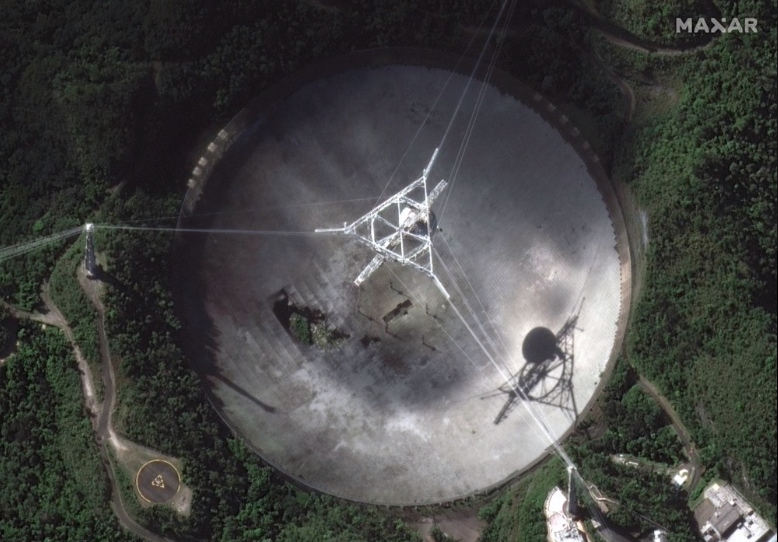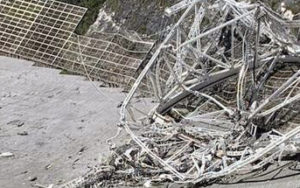

The huge, already damaged radio telescope run by the University of Central Florida in Puerto Rico that has played a key role in astronomical discoveries for more than half a century completely collapsed on Tuesday.
The telescope’s 900-ton receiver platform fell onto the reflector dish more than 400 feet below.
The U.S. National Science Foundation had earlier announced that the Arecibo Observatory would be closed. An auxiliary cable snapped in August, causing a 100-foot gash on the 1,000-foot-wide dish and damaged the receiver platform that hung above it. Then a main cable broke in early November.
The University of Central Florida has managed the observatory since early 2018.
“We knew this was a possibility, but it is still heartbreaking to see,” says Elizabeth Klonoff, vice president for research at UCF, which manages the facility for the NSF. “Safety of personnel is our number one priority. We already have engineers on site to help assess the damage and determine the stability and safety of the remaining structure. We will continue to work with the NSF and other stakeholders to find ways to support the science mission at Arecibo.”
The collapse occurred around 7:55 a.m. Puerto Rico time.
No injuries were reported as a result of the collapse, but it caused damage to the observatory dish and surrounding facilities. Extent of the damage is being assessed.
NSF intends to continue to authorize UCF to pay Arecibo staff and take actions to continue research work at the observatory, such as repairing the 12-meter telescope used for radio astronomy research and the roof of the LIDAR facility, a valuable geospace research tool. These repairs were funded through supplemental congressional appropriations aimed at addressing damage from Hurricane Maria.
Once safety on site is established, other work at the observatory will be carried out as conditions permit.
The collapse stunned many scientists who had relied on what was until recently the largest radio telescope in the world.
“It sounded like a rumble. I knew exactly what it was,” said Jonathan Friedman, who worked for 26 years as a senior research associate at the observatory and still lives near it. “I was screaming. Personally, I was out of control…. I don’t have words to express it. It’s a very deep, terrible feeling.”
Friedman ran up a small hill near his home and confirmed his suspicions: A cloud of dust hung in the air where the structure once stood, demolishing hopes held by some scientists that the telescope could somehow be repaired.
“It’s a huge loss,” said Carmen Pantoja, an astronomer and professor at the University of Puerto Rico who used the telescope for her doctorate. “It was a chapter of my life.”
Built in 1963, the dramatic-looking facility, a huge dish and dome carved into a limestone karst sinkhole in a Puerto Rican mountaintop forest, has been used as an onsite location for several movies including the James Bond installment “Goldeneye,” “Species,” and “Contact,” as well as for the TV series “The X-Files.”
Scientists worldwide had been petitioning U.S. officials and others to reverse the NSF’s decision to close the observatory. The NSF said at the time that it intended to eventually reopen the visitor center and restore operations at the observatory’s remaining assets, including its two LIDAR facilities used for upper atmospheric and ionospheric research, including analyzing cloud cover and precipitation data.
The telescope was built in the 1960s with money from the Defense Department amid a push to develop anti-ballistic missile defenses. It had endured hurricanes, tropical humidity and a recent string of earthquakes in its 57 years of operation.
The telescope has been used to track asteroids on a path to Earth, conduct research that led to a Nobel Prize and determine if a planet is potentially habitable. It also served as a training ground for graduate students and drew about 90,000 visitors a year.
“I am one of those students who visited it when young and got inspired,” said Abel Méndez, a physics and astrobiology professor at the University of Puerto Rico at Arecibo who has used the telescope for research. “The world without the observatory loses, but Puerto Rico loses even more.”
He last used the telescope on Aug. 6, just days before a socket holding the auxiliary cable that snapped failed in what experts believe could be a manufacturing error. The National Science Foundation, which owns the observatory that is managed by the University of Central Florida, said crews who evaluated the structure after the first incident determined that the remaining cables could handle the additional weight.
____
Republished with permission from The Associated Press. Florida Politics staff contributed to this report.



